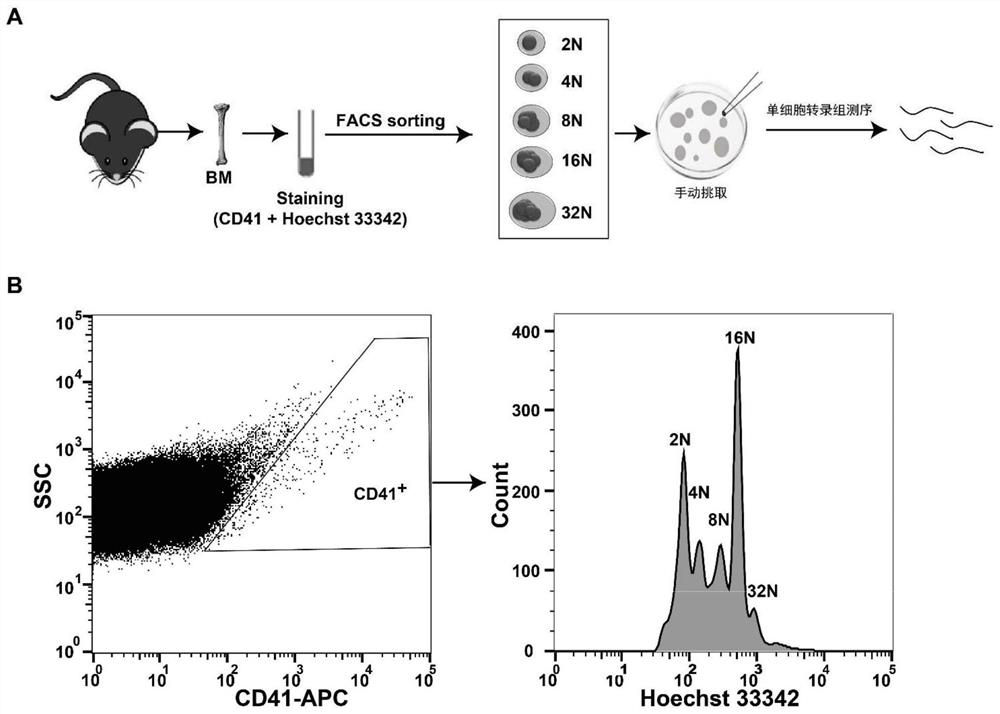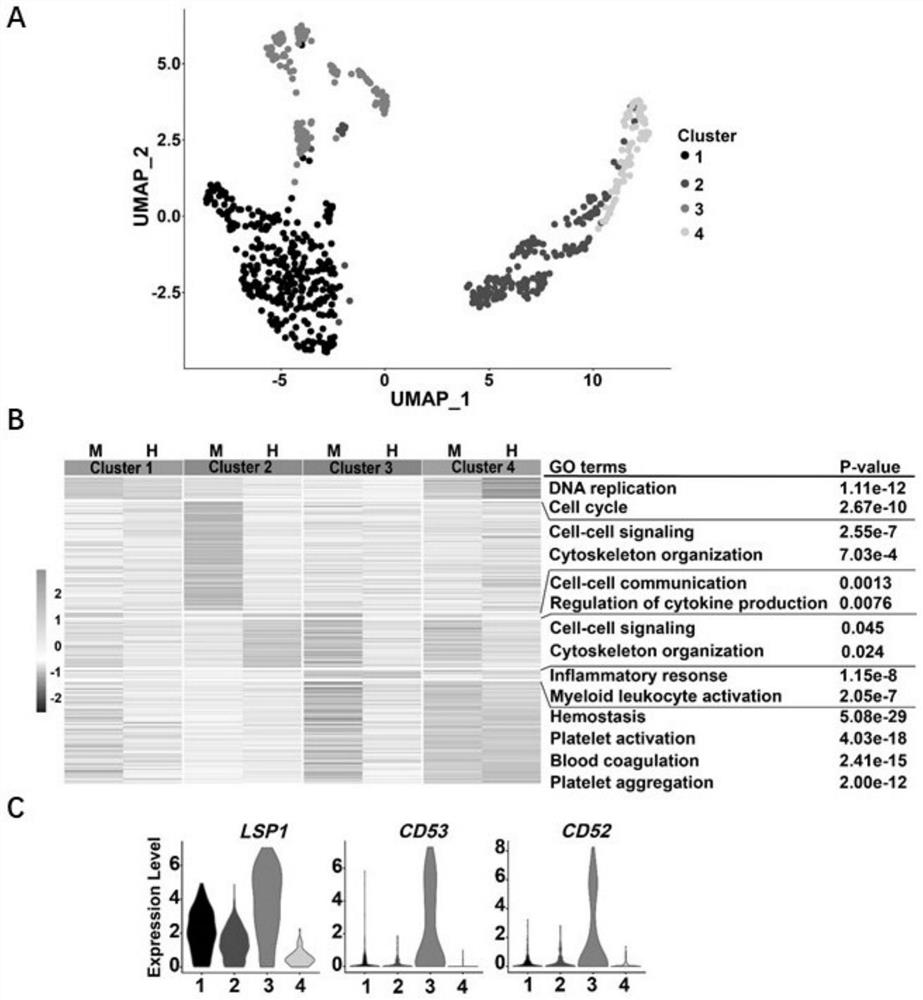Molecular marker combination and application thereof
A technique for using and labeling molecules, which is applied in the fields of cell biology and medicine, and can solve problems such as inability to distinguish megakaryocytes
- Summary
- Abstract
- Description
- Claims
- Application Information
AI Technical Summary
Problems solved by technology
Method used
Image
Examples
Embodiment 1
[0160] Example 1-Single-cell analysis found four megakaryocyte subpopulations and corresponding markers
[0161] Concrete experimental procedure, experimental result of the present embodiment are as follows:
[0162] 1. Experimental materials
[0163] (1) Experimental animals
[0164] C57BL / 6 mice were purchased from Beijing Weitong Lihua Experimental Animal Technology Co., Ltd. and bred at the Institute of Genetics and Development, Chinese Academy of Sciences.
[0165] (2) Donor bone marrow samples
[0166] Human bone marrow samples were obtained from 4 healthy male volunteers at the Institute of Hematology, Peking University People's Hospital. The acceptance of bone marrow samples from healthy volunteers was approved by the Ethics Committee of Peking University People's Hospital, in compliance with the regulations of the Declaration of Helsinki of the World Medical Association.
[0167] (3) Experimental reagents
[0168] Anti-mouse CD41 APC and anti-human CD41 APC antib...
Embodiment 2
[0184] Example 2 - Molecular markers can be used to label megakaryocyte subpopulations
[0185] Concrete experimental procedure, experimental result of the present embodiment are as follows:
[0186] 1. Experimental materials
[0187] (1) Experimental reagents
[0188] Anti-mouse CD105 PE and anti-mouse CD41 APC were purchased from eBioscience; rabbit polyclonal ARNTL antibody was purchased from Bio-Techne; anti-LSP1 antibody was purchased from Abcam; anti-MYLK4 polyclonal antibody was purchased from Cloud-Clone; MYLK4 rabbit polyclonal antibody was purchased from From Proteintech; goat anti-rabbit IgG AF488 and goat anti-rabbit IgG AF555 were purchased from Invitrogen; donkey anti-rabbit IgGDyLight 550 was purchased from Pierce; biotin anti-mouse Lineage Panel, biotin anti-mouse CD48 and BrilliantViolet 421 Streptavidin were purchased from BioLegend; 4% Paraformaldehyde (PFA) was purchased from YEASEN; sucrose was purchased from Amresco; EDTA was purchased from GIBCO; OCT...
Embodiment 3
[0209] Example 3 - Megakaryocytes marked by molecular markers have functions suggested by the transcriptome
[0210] 1. Experimental materials
[0211] Anti-mouse CD53 FITC was purchased from BioLegend; lipopolysaccharide LPS was purchased from Sigma; rabbit polyclonal ARNTL antibody was purchased from Bio-Techne; anti-LSP1 antibody was purchased from Abcam; anti-MYLK4 polyclonal antibody was purchased from Cloud-Clone; MYLK4 rabbit polyclonal antibody Purchased from Proteintech; goat anti-rabbit IgG AF488 and goat anti-rabbit IgG AF555 were purchased from Invitrogen; donkey anti-rabbit IgG DyLight 550 were purchased from Pierce; cell proliferation detection kit Cell Trace CFSE CellProliferation Kit and bacterial particles pHrodo Red E.coli BioParticles were purchased from Invitrogen.
[0212] 2. Experimental method
[0213] (1) LPS stimulation experiment
[0214] C57BL / 6 mice were injected intraperitoneally with 4mg / kg LPS, and the bone marrow of the mice treated for 0h,...
PUM
| Property | Measurement | Unit |
|---|---|---|
| diameter | aaaaa | aaaaa |
Abstract
Description
Claims
Application Information
 Login to View More
Login to View More - R&D
- Intellectual Property
- Life Sciences
- Materials
- Tech Scout
- Unparalleled Data Quality
- Higher Quality Content
- 60% Fewer Hallucinations
Browse by: Latest US Patents, China's latest patents, Technical Efficacy Thesaurus, Application Domain, Technology Topic, Popular Technical Reports.
© 2025 PatSnap. All rights reserved.Legal|Privacy policy|Modern Slavery Act Transparency Statement|Sitemap|About US| Contact US: help@patsnap.com



